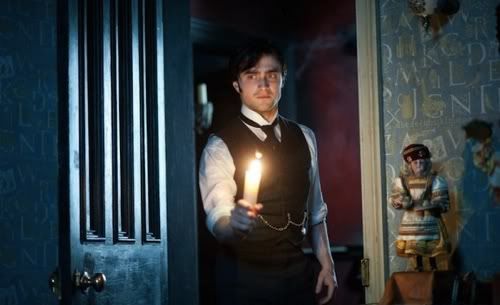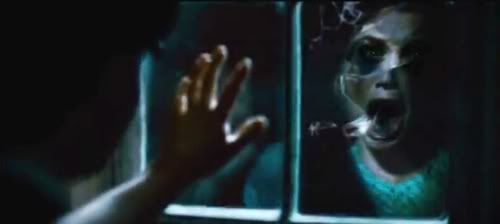Hammer Films is one of the most famous horror production companies out there. It’s filmography alone, between “The Mummy,” their “Dracula” films and “Frankenstein” movies, are just the tip of the iceberg in regards to what kind of memorable horror features they churned out one year after the next. Although they died off in the seventies, they’re back with a vengeance with their latest horror-thriller “The Woman in Black.”
Daniel Radcliffe stars as down-on-his-luck young lawyer and father who travels to a remote town in order to finish up the paperwork for a lady who passed. When he goes to the manor that the locals are all terrified about, he finds out the story about a scorned woman who will stop at nothing to make things right from beyond the grave.
Producer Simon Oakes and executive producer Nigel Sinclair talk about bringing Hammer Films back, making it bigger than ever and what it is about “The Woman in Black” that they love so much.
How did you find “The Woman in Black” tale? And how did you go about trying to adapt it?
Simon Oakes: It was a question of expanding the novel, which is quite thin, expanding it out into a feature film. It was just the question of finding the right and we were very fortunate to find Jane Goldman. She has now become one of the biggest screenwriters coming out of the UK. At the time she just finished “Kick Ass” and a couple of other pictures. She loves the genre, knows it and is a great fan of it. She broguht to the table that key element which was really pulling it out of the page and making it into a screenplay. That was probably the most important building block of putting this all together. We were just around at the right time at the right place.
That and you had Daniel Radcliffe, who’s fresh off the “Harry Potter” series, around at the right time too.

Nigel Sinclair: I think he’s kind of brave taking this on. This is his first film after “Harry Potter.” It’s been well recorded that he read the script the day after he finished his last day on “Harry Potter” for ten years. He immediately loved the script and wanted to do it. He was talking with the director in America, James Watkins, within twenty-four hours notice. He sat down and said he wanted to do this film, that he loved the script and that he wanted him to convince him to do it. A young man, playing a part like this on the screen pretty much all the time, goes and plays a young father that had to be believable, which it is. And then all the training he’s done.
Can you talk a little bit about how Hammer Films is back to life. How is the transition bringing it back into the mainstream.
Simon Oakes: The first thing was that we all sort of sat down and decided as a group what sort of films Hammer would make, what would we do, what we wouldn’t do, what our favorite Hammer films were, how important the story was to us. Finding different material which is obviously the great challenge because it’s unusual to get something that’s already ready-made, that’s packaged. We really had to develop things and find our sweet spot. You know, just come to a point where we felt that we had the right sort of material. We brought it up on an interesting time. We started with a small film called “Wake Wood” which was our pagan occult film where we found our feet. We then, as you know, went to make “The Resident” and “Let Me In.” “The Resident” was our sort of throwback to the Hitchcock films Hammer made in the late fifties and early sixties. It was important to have a psychological thriller like which we thought was important to have — it was pretty much part of his legacy. Then “Let Me In” which was a very beautifully made version of a remake of Tomas Alfredson’s “Let The Right One In.” And I suppose where we’re here today with “The Woman in Black,” in some ways that’s sort of fulfilled another part of the Hammer legacy which was a really old-fashioned gothic ghost story. So it’s sort of been a journey recently with building a slate, going forward and I’m very excited about this film.
It also feels kind of like a haunted house story too, which I really liked. Nigel, do you have anything to add on that with the Hammer Films question?
Nigel Sinclair: Well I think the whole — Hammer is trying to . What we found in hollywood and america is amongst artists and — it carries a resonance because people have a tradition which I think is why Daniel Radcliffe was prepared to do a Hammer Films movie and that been our jumping off point. I think this movie, which is — people seem to think it’s pretty good — this movie seems to be the combination of all the ideas that particularly Simon started off with in 2007.
Simon Oakes: That all being said, I think the question that you’re asking, and the question that we’ve been getting asked a lot is that in some ways the movie is a throwback in the genre to sort of the classic gothic horror stories which there haven’t been many made recently and there has been a sort of a focus on a different type of horror movie. I think we all agree that when making these films that horror is a very big pit. It can be vampire movies, it can be monster movies like jaws, it can be hitchcockian thrillers. It’s pretty broad family and I think it’s great to be making something that is more traditional and finding an audience for it. That’s sort of more — when you’re up at the judge the judge will be what happens within the next couple of weeks between here and around the world. We were really pleased that we had seem to have found a sweet spot with people who seem to still like something that’s a little old fashioned than it seems.
The story of “The Woman in Black” is kind of reminiscent of other old ghost tales in different tales. For instance, with the Mexican culture we were told about the story of La Llorona or the Weeping Woman. Does this tale remind you of any old stories that you were told when you were a kid?
Nigel Sinclair: Well Susan (Hill) wrote a book twenty odd years ago. It was a throwback to the ghost stories of Wilkie Collins for example from the Victorian Age. So in a sense there was a history to this type of storytelling and it was a successful novel at the time that turned into a play that was at the West End in London. I think the themes in the book are certainly themes that you’ve seen in other types of ghost stories, particularly around the mother and the loss of children apart from being a focal point. At the time I have to say we were captivated by how very frightening the play was, how it was frightening audiences. Even in a world that’s full of technology where there’s available frights on the internet, you still have sort of a residence because it was so believable. And I think that’s the most important thing.
It was very believable too because our audience was screaming every single time the woman in black appeared, or even if her shadow passed a room.

Nigel Sinclair: Well that’s good! What interests me is what happens in the play in London. The movie has obviously a lot more reality and intensity in the play, which is — if you ever go to the play, which has been playing for twenty six years in London, they scream like hell when the woman in black comes on.
Well it continues on! Now that “The Woman in Black” is out and Hammer Films is hustling and bustling, it’s out there again, what are your guys’ plans for the next big Hammer Film? Is it going to be another throwback to another kind of sub-genre or will it be something else?
Simon Oakes: Yes we do. As you may know, we are not focused on remaking old Hammer Films, we want to develop new material. We are working on a poltergeist movie but we can’t talk about it now, but we are working on one. I think we announced last year the partnership with Cross Creek Pictures where we’re going to produce a film called “Boneshaker” which is a period zombie movie based on Cherie Priest’s novel. And we have other things on the pipeline, we have a very active slate, it’s just that we can’t announce too much just yet.
“The Woman in Black” is out in theaters now.
